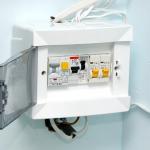
Understanding the Reasons Behind Your Safety Switch Going Off
What is a Safety Switch?
Situated in the fuse box, safety switches play a pivotal role in safeguarding both domestic and commercial electrical systems. Upon detecting an electrical imbalance in a circuit, the safety switch instantly disrupts the power supply within microseconds, thus reducing the possibility of electrical damage or personal harm.
Unlike circuit breakers or fuses which mainly protect against electrical overloads and short circuits, safety switches provide an added line of defence by primarily guarding the people from electric shocks. Three main types of safety switches can be found - Switchboard, Power Point, and Portable Safety Switches. Despite their different forms, their functionality remains uniform—to rapidly detect and terminate electrical faults, ensuring maximum safety.
Roles of a Safety Switch in Your Electrical System
The importance of safety switches within an electrical system is manifold. A key aspect of their functionality includes protection against electric shocks, which could otherwise lead to severe injuries or fatalities. They are, indeed, lifesaving devices.
Additionally, safety switches act as vigilant guards against potential electrical fires. In situations where conventional devices like fuses or circuit breakers fail to detect threats, safety switches trigger and cut off the circuit, preventing the overheating and ignition of flammable materials. Thus, the smooth operation and reliability of safety switches dramatically influence both electrical system safety and personal health safety.
Common Reasons Why a Safety Switch Might Go Off
Experiencing frequent safety switch tripping can indeed be a nuisance, yet it is a clear safety message not to be ignored. Generally, the prime reason for this might be an occurrence of an electrical overload - when too much current attempts to flow through your circuit beyond its capacity.
Short circuits also result in safety switches tripping. This takes place when live (active) wires and neutral wires touch each other within a certain electrical circuit, causing a sudden electrical surge.
Ground faults, another cause, occur when a live wire comes into unintended contact with a grounded wire, countering the circuit's usual flow and leading to an overload of electric current. Finally, appliances in your household with inherent faults can lead to your safety switch tripping. The switch significantly detects the faults and instantly disrupts the circulation of electricity, preventing potential hazards.
The Implications of the Safety Switch Going Off
If your safety switch trips regularly, it may indicate a major electrical problem. It is essential not to overlook these frequent trips, as they may be signalling a potential risk. An unstable electrical appliance may be a minor issue. Still, if your safety switch is continuously activating, it hints at a deeper underlying problem within your electrical circuitry.
Persistent safety switch activations, if ignored, could result in a hazardous situation over time. Device failures due to electrical surge damage or an increased likelihood of electrical fires or shocks are among the potential repercussions. Therefore, treating a frequently tripping safety switch as a pressing electrical issue is paramount.
Troubleshooting and Solutions for a Safety Switch that Keeps Going Off
When encountering a tripping safety switch, it's important not to panic. Initially, try to reset the switch. If it trips again, it's time to take a systematic approach to isolate the issue.
Unplug all electrical appliances connected to the circuit and try resetting the switch. If it remains on, reconnect the devices one by one. The device that causes the switch to trip identifies the problematic appliance.
However, when these basic troubleshooting steps do not resolve the issue, calling a licensed electrician to safely test and replace your safety switch is a wise decision. Professional assistance is crucial when dealing with electricity; attempted DIY solutions may increase the risk of potential hazards.
Conclusion
To wrap up, a safety switch being a critical element of an electrical system offers double-layered protection against shocks and fires by vigilantly monitoring the current flow in the circuit. While they operate silently, a frequently tripping safety switch communicates a loud safety message warranting attention. The issue could span from a minor appliance fault to a significant electrical failure. Hence, prompt action is encouraged. Ensure you contact a professional electrician swiftly when faced with a tripping safety switch to maintain a safe, efficient, and reliable electrical system.



